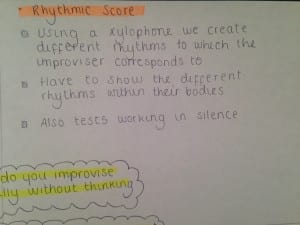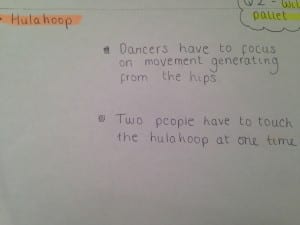Reading about Anna Halprin and her RSVP cycles prior to class really gave me a good insight into how she works with improvisation. Halprin worked with large groups of people often reaching into the hundreds, with “many of whom have no background in dance” (Worth and Poynor, 2004, 113). Some of her scores were very ritual in nature which is evident in the circle and earth scores, score four in particular emphasises this. Halprin’s rsvp cycles can also be open or closed scores. Open scores allow and encourage more exploration of movement, a closed score means that “all the actions are defined,” (Worth and Poynor, 2004, 114) making the improvisation less open to interpretation.
Huddle exercise
We began this exercise in the centre of the space as a collective in a huge huddle with our shoulders touching. One person would be asked to disrupt the huddle walking through it in different directions and as a group, we had to immediately close the gap after the person had walked through. This exercise got harder as more people were asked to disrupt the spacing. I believe our reaction time to closing the gap got slower, using your peripheral vision was essential as it began to become chaotic; a real focus was needed to close the gap efficiently.
Walking through groups exercise
This exercise was all about spatial awareness and being able to share the space when invading the kinesphere of others. We walked in lines crossing the other group’s pathways having to walk to the opposite side of the studio under a time limit. The longer the time limit the harder it was when intertwining between the other group, our group often found ourselves arriving too early. When the time limit decreased our group was more focused because we had to travel and get to our destination, when merging through the other group under a quicker time limit I found it a lot smoother because we had less thinking time.
Exploring kinesphere
We first were to explore kinesphere on a low level, then a medium level and then a high level. When improvising on a low level, I tried to explore different ways of moving through the floor, my movement did began to get repetitious especially when starting off my movement. I had to experiment ways of beginning the improvisation. When improvising on a high kinesphere, I would improvise dynamic movements and would often try and be on a rise so this was clear. My movement however did start to become a little habitualised when I started doing high kicks and hops. To combat this I tried to be more iternal with my improvisation working with how my body was feeling and started improvising much smaller movements. We then had to improvise with all kinesphere’s but focus on using stillness, having high energy and then slowing the movement down. With all these things to keep in mind, trying to improvise the next movement became more difficult and I found myself focusing on just the kinesphere aspect of it.
Creating our score
In relation to Halprin’s RSVP cycle we decided collectively on our resources, score and valuaction. For our resources we wanted to have all the group in the space but split them into four groups and have them improvising in different parts of the room. This meant that everybody was moving at the same time but improvising to different scores. We thought this would be aesthetical for an audience to watch because of how different each group’s movement would look. The improvisers would move for 2 minutes before swapping over.
For our valuaction we posed two questions:
- How do you improvise successfully without thinking time?
- Will broadening my movement pallet help boost my confidence?
We wanted the performance of our scores to be visually interesting to watch, therefore we suggested adding objects into our score for the improvisers to work with. We believed this would allow them to create new and interesting movement based both on imagery and improvising with an unknown item.
Our score is explained in brief in the diagrams below:
We believed the rhythmic score would allow the improviser to not have to stop and think of their next movement. The rhythms in this score were constantly changing meaning that they had no time to stop and think, their movement was continuous. We wanted this particular score to be challenging and it was fascinating to watch how their bodies changed from one rhythm to the next.
Using imagery and objects in our other scores allowed the improvisers to break away from habitual tendencies and from observing, I could see individuals starting to push their bodies into the unknown. In the score using a basketball as imagery, it was interesting to see people trying to make unusual shapes and using the ball to improvise with.
I really enjoyed creating our new scores and loved getting involved in improvising other peoples. It was fascinating to watch how people adapted their movement with each score they worked with.
Bibliography
Worth, L. and Poynor, H. (2004) Anna Halprin. London: Routledge.



